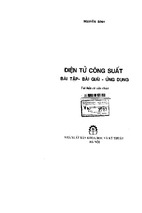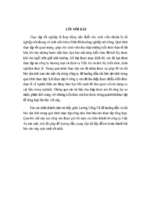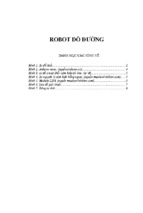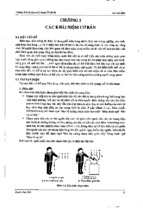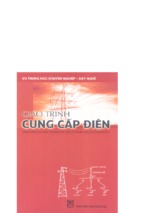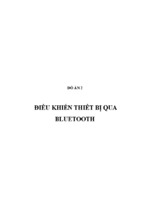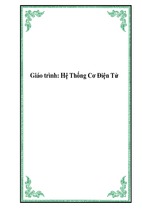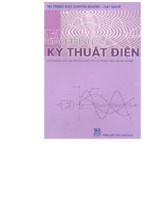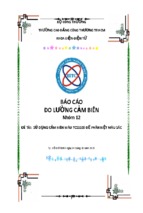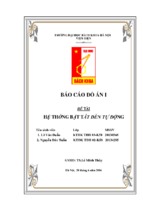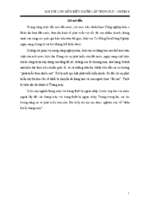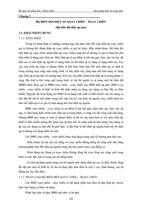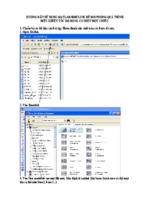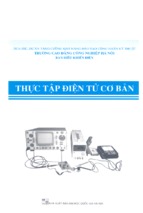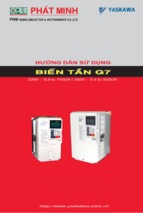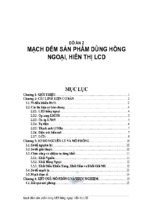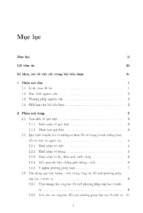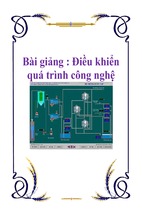391
Wheeled Rob
17. Wheeled Robots
Guy Campion, Woojin Chung
The purpose of this chapter is to introduce, analyze, and compare the models of wheeled mobile
robots (WMR) and to present several realizations
and commonly encountered designs. The mobility
of WMR is discussed on the basis of the kinematic
constraints resulting from the pure rolling conditions at the contact points between the wheels
and the ground. According to this discussion it is
shown that, whatever the number and the types
of the wheels, all WMR belong to only five generic
classes. Different types of models are derived and
compared: the posture model versus the configuration model, the kinematic model versus the
dynamic model. The structural properties of these
models are discussed and compared. These models
as well as their properties constitute the background necessary for model-based control design.
Practical robot structures are classified according to
the number of wheels, and features are introduced
focusing on commonly adopted designs. Omnimobile robots and articulated robots realizations are
described in more detail.
17.1 Overview.............................................. 391
17.2 Mobility of Wheeled Robots ...................
17.2.1 Types of Wheels ...........................
17.2.2 Kinematic Constraints ...................
17.2.3 Robot Configuration Variables........
17.2.4 Restriction on Robot Mobility.........
392
392
394
396
396
17.2.5 Characterization of Robot Mobility.. 397
17.2.6 The Five Classes
of Wheeled Mobile Robots ............. 398
17.3 State-Space Models
of Wheeled Mobile Robots .....................
17.3.1 Posture Kinematic Models .............
17.3.2 Configuration Kinematic Models.....
17.3.3 Configuration Dynamic Models.......
17.3.4 Posture Dynamic Models ...............
17.3.5 Articulated Robots ........................
17.4 Structural Properties
of Wheeled Robots Models ....................
17.4.1 Irreducibility, Controllability,
and Nonholonomy .......................
17.4.2 Stabilizability ..............................
17.4.3 Static State-Feedback
Linearizability..............................
17.4.4 Dynamic State-Feedback
Linearizability – Differential
Flatness ......................................
17.5 Wheeled Robot Structures .....................
17.5.1 Robots with One Wheel .................
17.5.2 Robots with Two Wheels ...............
17.5.3 Robots with Three Wheels .............
17.5.4 Four Robots with Four Wheels........
17.5.5 Special Applications
of Wheeled Robots .......................
398
398
399
400
401
401
403
403
404
404
404
405
405
405
406
408
408
17.6 Conclusions .......................................... 409
References .................................................. 410
17.1 Overview
Throughout the chapter we make the assumption
that the wheels satisfy the kinematic constraints relative to the pure rolling conditions at each contact
wheel/ground, without sliding effects. This implies that
we assume that the contact forces between the ground
and the wheels magically take the right values allow-
Part B 17
The purpose of this chapter is to provide a general
description of wheeled mobile robots, to discuss their
properties from the mobility point of view, to introduce several dynamical models necessary for the design
of model-based control laws, and to describe the most
commonly encountered realizations of such robots.
392
Part B
Robot Structures
ing the satisfaction of these conditions; this is an ideal
model In reality the contact forces appear as a consequence of local sliding, according to phenomenological
contact force models. Using a singular perturbation
approach it can be shown however that these sliding
effects correspond to fast dynamics, i. e., to dynamical effects with characteristic times that are quite short
with respect to the dynamics of the global motion of the
robot, and can therefore be neglected, at least when using the ideal model for control design purpose [17.1]
(Chap. 34).
The chapter is organized as follows. Section 17.2
is devoted to the characterization of the restriction
of robot motion induced by these pure rolling conditions. We first describe the different types of wheels
used in the construction of mobile robots and derive
the corresponding kinematic constraints. This allows
us to characterize the mobility of a robot equipped
with several wheels of these different types, and we
show that these robots can be classified into only
five categories, corresponding to two mobility indices.
In Sect. 17.3, we present four types of generic statespace models allowing one to describe robot behavior
within each of these five categories, and the relationships between these models. We introduce kinematic and
dynamic models, whose inputs are, respectively, velocities and accelerations (or, equivalently input torques),
as well as posture or configuration models, corresponding to a minimal description of the robot behavior, or
to a full description, including the internal variables,
respectively.
In Sect. 17.4, we present several structural properties
of these models, from a control design point of view. We
first discuss the questions of stabilizability, controllability, and nonholonomy of restricted mobility robots. We
then discuss the problem of state feedback linearization,
either input–output linearization by static state feedback,
or full linearization by dynamic extension and dynamic
state feedback.
In the last section we present several realizations
of wheeled mobile robots, with several particular devices such as synchronous drive, Swedish wheels, and
articulated robots.
17.2 Mobility of Wheeled Robots
In this section we describe a variety of wheels and wheel
implementations in mobile robots. We discuss the restriction of robot mobility implied by the use of these
wheels and deduce a classification of robot mobility allowing one to characterize robot mobility fully, whatever
the number and type of the wheels.
design of a standard wheel. Three conditions should be
defined for a standard wheel design:
Part B 17.2
17.2.1 Types of Wheels
1. the determination of the two offsets d and b
2. a mechanical design that allows steering motion or
not (i. e., to fix the wheel orientation or not)
3. the determination of steering and driving actuation
(i. e., active or passive drive)
In order to achieve robot locomotion, wheeled mobile
robots are widely used in many applications. In general,
wheeled robots consume less energy and move faster
than other locomotion mechanisms (e.g., legged robots
or tracked vehicles). From the viewpoint of control, less
control effort is required, owing to their simple mechanisms and reduced stability problems. Although it is
difficult to overcome rough terrain or uneven ground
conditions, wheeled mobile robots are suitable for a large
class of target environments in practical applications.
When we think of a single-wheel design, there are two
candidates: a standard wheel or a special wheel. A standard wheel can be understood as a conventional tire.
Special wheels possess unique mechanical structures including rollers or spheres. Figure 17.1 shows the general
Condition 1 is the kinematic parameter design problem for a single standard wheel. The parameter d can
be either 0 or some positive constant. Parameter b is the
lateral offset of the wheel and is usually set to zero. In
a special design, a nonzero b may be selected to obtain
pure rolling contact between the wheel and ground without causing rotational slip at the contact point. However,
this is rarely used and we mainly consider the case of
zero lateral offset b.
Condition 2 is a design problem for whether the
wheel orientation can be changed or not. If the steering
axis is fixed, the wheel provides a velocity constraint
on the driving direction. Condition 3 is the design problem of whether to actuate steering or driving motion by
actuators or to drive steering or motion passively.
Wheeled Robots
a)
17.2 Mobility of Wheeled Robots
393
a) YR
b)
β
Robot
chassis
l
α
A
υ
p
XR
b) X1
d
b
Caster
wheel
c) X1
B
b
A
d
B
β
d
d
l
β
A
α
Robot
chassis
p
l
p
A
α
X2
c) YR
Robot
chassis
X2
β (t)
Fig. 17.1a–c The general design of a standard wheel.
(a) side view (b) front view (c) top view
l
p
α
A
υ
XR
Fig. 17.2a–c Structures of standard wheels. (a) Passive
fixed wheel. (b) Passive or active, off-centered orientable
wheel. (c) Active orientable wheel without offsets
In such a case, the steering motion should not be passive
because the wheel orientation cannot be changed passively. However, the driving velocity can be determined
passively by actuation of other wheels. Wheel orientation should be actively steered to the desired velocity
direction due to the nonholonomic velocity constraint.
This implies that the wheel orientation should be aligned
before movement.
In summary, four types of standard wheels are commonly used. The first is a passively driven wheel with
Part B 17.2
If steering motion is allowed, the offset d plays
a significant role in the kinematic modeling. For a conventional caster wheel (i. e., an off-centered orientable
wheel), there is a nonzero offset d. Point A in Fig. 17.1
indicates the location of the joint connecting the wheel
module to the robot chassis. Two orthogonal linear velocity components at point A are obtained by a caster
wheel, which result from the steering and driving motions of the wheel module. This implies that a passive
caster wheel does not provide an additional velocity
constraint on the robot’s motion. If a caster wheel is
equipped with two actuators that drive steering and driving motions independently, holonomic omnidirectional
movement can be achieved because any desired velocity at point A can be generated by solving the inverse
kinematics problem.
If the offset d is set to zero, the allowable velocity
direction at point A is limited to the wheel orientation.
Robot
chassis
394
Part B
Robot Structures
Fig. 17.3 (a) Swedish wheel. (b) Attachment of a Swedish
wheel and (c) spherical wheel [17.2]
a)
b) X2
β
γ
Robot chassis
A
l
α
p
c)
X1
ω0
Drive roller
Motor
ω1
Y
θ= 0
Encoders
Part B 17.2
ω2
X
a fixed steering axis. The second is a passive caster wheel
with offset d. The third is an active caster wheel with
offset d, where the steering and driving motions are con-
trolled by actuators. The fourth is an active orientable
wheel with zero offset d, where steering and driving
motions are driven by actuators. The structures of each
wheel type are shown in Fig. 17.2. The kinematics and
constraints of those wheels will be explained in detail in
Sect. 17.2.2.
Although standard wheels are advantageous because of their simple structure and good reliability, the
nonholonomic velocity constraint (i. e., no side-slip condition) limits robot motion. On the other hand, special
wheels can be employed in order to obtain omnidirectional motion of a mobile robot (omnimobile robot),
i. e., to ensure three degrees of freedom for plane motion. We consider two typical designs of special wheels:
the Swedish wheel and the spherical wheel. Figure 17.3a
shows the Swedish wheel. Small passive free rollers are
located along the outer rim of the wheel. Free rollers are
employed in order to eliminate the nonholonomic velocity constraint. Passive rollers are free to rotate around
the axis of rotation, which results in lateral motion of
the wheel. As a result, a driving velocity should be controlled, while the lateral velocity is passively determined
by the actuation of the other wheels.
A spherical wheel is shown in Fig. 17.3c. The rotation of the sphere is constrained by rollers that make
rolling contact with the sphere. The rollers can be divided into driving and supporting rollers. The sphere
is driven by actuation of the driving rollers, whereas
the rolling contacts provide nonholonomic constraints,
and the resultant motion of the sphere module becomes holonomic. This implies that the robot can
be moved with any desired linear/angular velocities
at any time. By using the spherical wheel, a holonomic omnidirectional mobile robot can be developed
and the robot achieves smooth and continuous contact between the sphere and the ground. However, the
design of the sphere-supporting mechanism is difficult and the payload must be quite low due to the
point contact. Another drawback is that the surface of
the sphere can be polluted when traveling over dirty
ground and it is difficult to overcome irregular ground
conditions. These drawbacks limit the practical application of the spherical wheel. An example of the use
of spherical wheels can be found in [17.2] and [17.3].
The spherical structure can also be applied to special
robotic transmissions; examples include the nonholonomic manipulator in [17.4] and the passive haptic
system in [17.5].
Wheeled Robots
We assume, as a first step, that the mobile robot under
study is made up of a rigid cart equipped with nondeformable wheels, and that it is moving on a horizontal
plane. The position of the robot on the plane is described,
with respect to an arbitrary inertial frame, by the posture
vector ξ = (x y θ)T , where x and y are the coordinates
of a reference point P of the robot cart, while θ describes
the orientation of a mobile frame attached to the robot,
with respect to the inertial frame (Fig. 17.4).
We assume that, during motion, the plane of each
wheel remains vertical and the wheel rotates around
its horizontal axle, whose orientation with respect to the
cart can be fixed or varying. We distinguish between two
basic classes of idealized wheels, namely conventional
and the Swedish wheels. In each case, it is assumed
that the contact between the wheel and the ground is
reduced to a single point. The kinematic constraints
result from the fact that the velocity of the material
point of the wheel in contact with the ground is equal to
zero.
For a conventional wheel, the kinematic constraints
imply that the velocity of the center of the wheel is
parallel to the wheel plane (nonslip condition) and
is proportional to the wheel rotation velocity (pure
rolling condition). For each wheel the kinematic constraints therefore result in two independent conditions.
For a Swedish wheel, due to the relative rotation of the
rollers with respect to the wheel, only one of the velocity components of the wheel contact point is zero. The
direction of this zero component is fixed with respect to
the wheel plane and depends on the wheel construction.
l2
X2
X1
Conventional Wheels
We now derive the general form of the kinematic constraints for a conventional wheel.
As shown in Fig. 17.2, there are several variations
of the conventional wheel design. First, we focus on the
off-centered orientable wheel in Fig. 17.2b. The center of
the wheel, B, is connected to the cart by a rigid rod from
A (a fixed point on the cart) to B, aligned with the wheel
plane. The rod, whose length is denoted by d, can rotate
around a fixed vertical axle at point A. The position of A
is specified by two constant polar coordinates, l and α,
with respect to the reference point P. The rotation of the
rod with respect to the cart is represented by the angle
β. The radius of the wheel is denoted by r, and its angle
of rotation around its horizontal axle is denoted ϕ. The
description therefore involves four constant parameters:
α, l, r, and d, and two variables: ϕ(t) and β(t).
With these notations the kinematic constraints are
derived as follows.
We make the derivation explicit for the general situation corresponding to a caster wheel (Fig. 17.2b). For
fixed or steering wheels one just has to consider either
the case d = 0 and constant β (fixed wheels), or d = 0
and variable β (steering wheels).
First we evaluate the velocity of the center of the
wheel, which results from the following vector expresd
d
d
d
sion dt OB = dt OP + dt PA + dt AB. The two components of this vector in the robot frame are expressed
˙
˙ ˙
as: x cos θ + y sin θ − l θ sin α + (θ + β)d cos(α + β) and
˙
˙
˙
˙ ˙
−x sin θ + y cos θ − l θ cos α + (θ + β)d sin(α + β).
˙
˙
The projections of this vector onto the direction
of the wheel plane, i. e., onto the vector (cos(α + β −
π/2), sin(α + β − π/2)) and the vector of the wheel
axle (cos(α + β), sin(α + β)), are r ϕ and 0, respectively,
˙
corresponding to the pure rolling and nonslip conditions.
After some manipulations, these conditions can be
rewritten in the following compact form.
Pure rolling condition:
˙
(− sin(α + β) cos(α + β) l cos β)R(θ)ξ + r ϕ = 0 ,
˙
θ
Robot chassis
395
For such wheels the kinematic constraints result in only
one condition.
17.2.2 Kinematic Constraints
y
17.2 Mobility of Wheeled Robots
(17.1)
P
˙
˙
(− cos(α + β) sin(α + β) d + l sin β)R(θ)ξ + d β
=0.
(17.2)
x
l1
Fig. 17.4 The posture definition of a mobile robot on a plane
In these expressions R(θ) is the orthogonal rotation matrix expressing the orientation of the robot with
Part B 17.2
Nonslip condition:
396
Part B
Robot Structures
respect to the inertial frame, i. e.,
⎛
⎞
cos θ sin θ 0
⎜
⎟
R(θ) = ⎝− sin θ cos θ 0⎠ .
0
0
•
(17.3)
1
As said before, these general expressions can be simplified for the different types of conventional wheels.
For fixed wheels, the center of the wheel is fixed with
respect to the cart and the wheel orientation is constant.
This corresponds to a constant value of β and d = 0
(Fig. 17.2a). The nonslip equation (17.2) then reduces
to
˙
(cos(α + β) sin(α + β) l sin β)R(θ)ξ = 0 .
(17.4)
For steering wheels, the center of the wheel is also
fixed with respect to the cart (i. e., d = 0), with β timevarying, so the nonslip equation takes the form (17.2).
This structure was already introduced in Fig. 17.2c.
The situation described by (17.1) and (17.2), with
a nonzero-length rod AB and time-varying orientation
angle β corresponds to caster wheels.
Swedish Wheels
The position of a Swedish wheel with respect to the cart
is described, as for a fixed wheels, by three constant parameters: α, β, and l. An additional parameter is required
to characterize the direction, with respect to the wheel
plane, of the zero component of the velocity at the contact point of the wheel. This parameter is γ , which is
the angle between the axle of the rollers and the wheel
plane (Fig. 17.3b).
The kinematic constraints now impose only one
condition:
(− sin(α + β + γ ) cos(α + β + γ ) l cos(β + γ ))
˙
(17.5)
× R(θ)ξ + r cos γ ϕ = 0 .
˙
17.2.3 Robot Configuration Variables
Part B 17.2
We now consider a wheeled robot equipped with N
wheels of the above described types. We use the following subscripts to identify quantities related to these
four types: ‘f’ for fixed wheels, ‘s’ for steering wheels,
‘c’ for caster wheels, and ‘sw’ for Swedish wheels. The
numbers of wheels of each type are denoted by Nf , Ns ,
Nc , and Nsw , with N = Nf + Ns + Nc + Nsw .
The configuration of the robot is fully described by
the following generalized coordinate vector.
•
posture coordinates: the posture vector ξ(t) =
(x(t) y(t) θ(t)) ;
•
orientation coordinates: the Ns + Nc orientation
angles of the steering and caster wheels, i. e.,
β(t) = (βs (t) βc (t)) ;
rotation coordinates: the N rotation angles of the
wheels, i. e., ϕ(t) = (ϕf (t) ϕs (t) ϕc (t) ϕsw (t))
This whole set of coordinates is termed the set of configuration coordinates. The total number of configuration
coordinates is Nf + 2Ns + 2Nc + Nsw + 3.
17.2.4 Restriction on Robot Mobility
The pure rolling conditions for fixed, steering, and caster
wheels, as well as the constraints relative to the Swedish
wheels, can be written in the following compact form
˙
J1 (βs , βc )R(θ)ξ + J2 ϕ = 0 ,
˙
with
(17.6)
⎛
⎞
J1f
⎜
⎟
⎜ J (β ) ⎟
J1 (βs , βc ) = ⎜ 1s s ⎟ .
⎝ J1c (βc )⎠
J1sw
In this expression J1f , J1s (βs ), J1c (βc ), and J1sw are,
respectively, (Nf × 3), (Ns × 3), (Nc × 3), and (Nsw × 3)
matrices, whose forms derive directly from the kinematic constraints, while J2 is a constant (N × N)
diagonal matrix whose entries are the radii of the wheels,
except for the radii of the Swedish wheels which are
multiplied by cos γ .
The value γ = π would correspond to the direction
2
of the zero component of the velocity being orthogonal
to the plane of the Swedish wheel. Such a wheel would
be subject to a constraint identical to the nonslip condition for a conventional wheel, hence losing the benefit of
implementing a Swedish wheel. This implies that γ = π
2
and that J2 is a nonsingular matrix.
The nonslip conditions for caster wheels can be
summarize as
˙
˙
C1c (βc )R(θ)ξ + C2c βc = 0 ,
(17.7)
where C1c (βc ) is a (Nc × 3) matrix, whose entries derive from the nonslip constraints (17.2), while C2c is
a constant diagonal nonsingular matrix, whose entries
are equal to d.
The last constraints relate to the nonslip conditions
for fixed and steering wheels. They can be summarized
as
∗
˙
C1 (βs )R(θ)ξ = 0 ,
(17.8)
Wheeled Robots
where
C1f
∗
C1 (βs ) =
C1s (βs )
17.2 Mobility of Wheeled Robots
a)
,
where C1f and C1s (βs ) are, respectively, Nf × 3 and
Ns × 3 matrices.
It is important to point out that the restrictions on
robot mobility result only from the conditions (17.8)
involving the fixed and the steering wheels. These condi∗
˙
tions imply that the vector R(θ)ξ belongs to N[C1 (βs )],
∗ (β ). For any R(θ)ξ satis˙
the null space of the matrix C1 s
fying this condition, there exists a vector ϕ and a vector
˙
˙
βc satisfying, respectively, conditions (17.6) and (17.7),
because J2 and C2c are nonsingular matrices.
∗
Obviously rank[C1 (βs )] ≤ 3. If it is equal to 3 then
˙ = 0, which means that any motion in the plane is
R(θ)ξ
impossible. More generally, restrictions on robot mobil∗
ity are related to the rank of C1 (βs ), as will be discussed
in detail below.
It is worth noticing that condition (17.8) has a direct geometrical interpretation. At each time instant the
motion of the robot can be viewed as an instantaneous
rotation about the instantaneous center of rotation (ICR),
whose position with respect to the cart can be time varying. At each instant the velocity of any point of the cart
is orthogonal to the straight line joining this point and
the ICR. This is true, in particular, for the centers of the
fixed and steering wheels, which are fixed points of the
cart. On the other hand, the nonslip condition implies
that the velocity of the wheel center is aligned with the
wheel plane. These two facts imply that the horizontal
rotation axles of the fixed and steering wheels intersect
at the ICR (Fig. 17.5). This is equivalent to the condition
∗
that rank[C1 (βs )] ≤ 3.
17.2.5 Characterization of Robot Mobility
As said before the mobility of the robot is directly related
∗
to the rank of C1 (βs ), which depends on the design of
the robot. We define the degree of mobility δm as
∗
δm = 3 − rank[C1 (βs )] .
(17.9)
ICR
Fig. 17.5a,b The instantaneous center of rotation. (a) A car-like
robot; (b) a three-steering-wheels robot
∗
Moreover, we assume that rank[C1 (βs )] = rank(C1f )
+ rank[C1s (βs )] ≤ 2.
These two assumptions are equivalent to the following set of conditions.
1. If the robot has more than one fixed wheel, they are
all on a single common axle.
2. The centers of the steering wheels do not belong to
this common axle of the fixed wheels.
∗
3. The number rank[C1 (βs )] is equal to the number of
steering wheels that can be oriented independently
in order to steer the robot.
We call this number the degree of steerability:
δs = rank[C1s (βs )] .
(17.10)
If a robot is equipped with more than δs steering
wheels, the motion of the extra wheels must be coordinated in order to guarantee the existence of the ICR at
each instant.
We conclude that, for wheeled mobile robot of practical interest, the two defined indices, δm and δs , satisfy
the following conditions.
1. The degree of mobility satisfies 1 ≤ δm ≤ 3. The upper bound is obvious, while the lower bound means
that we consider only cases where motion is possible.
2. The degree of steerability satisfies 0 ≤ δs ≤ 2. The
upper bound can be reached only for robots without
fixed wheels, while the lower bound corresponds to
robots without steering wheels.
3. The following is satisfied: 2 ≤ δm + δs ≤ 3.
The case δm + δm = 1 is not acceptable because it
corresponds to the rotation of the robot about a fixed
ICR. The cases δm ≥ 2 and δs = 2 are excluded because,
according to the above assumptions, δs = 2 implies
δs = 1. These conditions imply that only five structures
are of practical interest, corresponding to the five pairs
(δm , δs ) satisfying the above inequalities, according to
Part B 17.2
Let us first examine the case rank(C1f ) = 2, which implies that the robot has at least two fixed wheels. If there
are more than two fixed wheels, their axles intersect at
the ICR, whose position with respect to the cart is then
fixed in such a way that the only possible motion is a rotation of the cart about this fixed ICR. Obviously, from
the user’s point of view, such a design is not acceptable.
We therefore assume that rank(C1f ) ≤ 1.
b)
ICR
397
398
Part B
Robot Structures
the following array.
δm 3 2 2 1 1
δs 0 0 1 1 2
Below, each type of structure will be designated by using
a denomination of the form type (δm , δs ) robot.
17.2.6 The Five Classes
of Wheeled Mobile Robots
We now briefly describe the five classes of wheeled robot
structures, pointing out the mobility restriction inherent
to each class. Details and examples can be found in
Sect. 17.5 and in [17.6].
Type (3,0) Robots
These robots have no fixed and no steering wheels and
are equipped only with Swedish or caster wheels. Such
robots are called omnimobile, because they have full
mobility in the plane, which means that they are able to
move in any direction without any reorientation.
Type (2,0) Robots
These robots have no steering wheels, but either one or
several fixed wheels with a common axle. Mobility is
restricted in the sense that, at a given posture ξ(t), the ve˙
locity ξ (t) is constrained to belong to a two-dimensional
distribution spanned by the vector fields R (θ)s1 and
R (θ)s2 , where s1 and s2 are two constant vectors spanning N(C1f ). A typical example of such a robot is the
wheelchair.
Type (2,1) Robots
These robots have no fixed wheels and at least one
steering wheel. If there is more than one steering
wheel, their orientations must be coordinated in such
˙
a way that rank[C1s (βs )] = δs = 1. The velocity ξ (t)
is constrained to belong to a two-dimensional distribution spanned by the vector fields R (θ)s1 (βs ) and
R (θ)s2 (βs ), where s1 (βs ) and s2 (βs ) are two vectors
spanning N(C1s (βs )).
Type (1,1) Robots
These robots have one or several fixed wheels on
a single common axle, and also one or several
steering wheels, with the conditions that their centers are not located on the common axle of the
fixed wheels, and that their orientations are coordi˙
nated. The velocity ξ (t) is constrained to belong to
a one-dimensional distribution parameterized by the
orientation angle of one arbitrarily chosen steering
wheel. Mobile robots built on the model of a conventional car (often called car-like robots) belong to this
class.
Type (1,2) Robots
These robots have no fixed wheels, but at least two steering wheels. If there are more than two steering wheels,
then their orientation must be coordinated in order to
satisfy the condition rank[C1s (βs )] = δs = 2. The veloc˙
ity ξ (t) is constrained to belong to a one-dimensional
distribution parameterized by the orientation angles of
two arbitrarily chosen steering wheels.
17.3 State-Space Models of Wheeled Mobile Robots
In this section, the mobility analysis discussed in the previous section is reformulated into a state-space form that
will be useful for subsequent developments. We introduce four different kinds of state-space representation
that are of interest for understanding the behavior of
wheeled robots, and for control design purpose.
•
Part B 17.3
•
•
The posture kinematic model, which is the simplest
state-space model able to give a global description
of the robot, from the users viewpoint.
The configuration kinematic model allows one to
describe the kinematic behavior of the whole robot,
including all the configuration variables.
The configuration dynamic model is the most general
state-space model. It gives a complete description of
•
the dynamics including the forces provided by the
actuators. In particular, it allows to one address the
issue of actuator configuration and to define a criterion to check whether the motorization is sufficient
to exploit the kinematic mobility fully.
The posture dynamic model, which is feedback
equivalent to the configuration dynamic model,
constitutes a dynamical counterpart to the posture
kinematic model.
17.3.1 Posture Kinematic Models
We have shown that, whatever the type of robot, the ve˙
locity vector ξ (t) is restricted to belong to a distribution
Wheeled Robots
Δc defined as
˙
ξ ∈ Δc = span{col[R (θ)Σ(βs )]} ,
where the columns of the matrix Σ(βs ) constitute a ba∗
sis of N[C1 (βs )]. This is equivalent to the following
statement: for all t, there exists a vector η such that
˙
ξ = R (θ)Σ(βs )η ,
(17.11)
The dimension of the distribution Δc , and hence of the
vector η(t), is equal to the degree of mobility δm of
the robot. Obviously, in the case where the robot has
no steering wheels, the matrix Σ is constant, and the
expression (17.11) reduces to
˙
ξ = R (θ)Ση .
(17.12)
In the opposite case (δs ≥ 1), the matrix Σ explicitly
depends on the orientation angles βs , and the expression
(17.11) can be augmented as follows:
˙
ξ = R (θ)Σ(βs )η ,
˙
βs = ς .
(17.13)
(17.14)
399
the inputs ς(t). However, the action of ς(t) on the pos˙
ture coordinates ξ (t) is indirect, since it is achieved only
through the coordinates βs , which are related to the inputs ς(t) by an integral action, reflecting the fact that the
modification of the orientation of a steering wheel cannot be achieved instantaneously. The maneuverability of
a wheeled robot depends not only on δM , but also on the
way these δM degrees of freedom are partitioned into δm
and δs . Therefore, two indices are needed to characterize the maneuverability. Obviously the ideal situation is
that of omnimobile robots where δM = δm = 3.
In order to avoid useless notational complications,
we will assume from now on that the degree of steerability is equal to the number of steering wheels, i. e.,
Ns = δs . This is a restriction from a robot design viewpoint. However, for the mathematical analysis of the
behavior of mobile robots, there is no loss of generality
in this assumption, although it considerably simplifies
the technical derivation. Indeed, for robots with an excess of steering wheels, it is always possible to reduce
the condition (17.8) to a minimal subset of exactly δs independent constraints that correspond to the δs wheels
that have been selected as the master steering wheels
and to ignore the other slave wheels in the analysis.
17.3.2 Configuration Kinematic Models
In order to discuss the restriction of mobility, we have
considered only a subset of the conditions induced by
the kinematic constraints, namely the nonslip conditions
for the fixed and steering wheels (17.8). The remaining
constraints are now used to derive the equations of evolution of the rotation velocities ϕ and of the orientation
˙
˙
velocities of the caster wheels βc . From (17.6) and (17.7)
it follows immediately that
−1
˙
˙
βc = −C2c C1c (βc )R(θ)ξ ,
−1
˙
ϕ = −J2 J1 (βs , βc )R(θ)ξ .
˙
(17.15)
(17.16)
By combining these equations with the posture kinematic model (17.13), the state equations for βc and ϕ
become
˙
βc = −D(βc )Σ(βs )η ,
ϕ = −E(βs , βc )Σ(βs )η ,
˙
where
−1
D(βc ) = −C2c C1c (βc ) and
−1
E(βs , βc ) = −J2 J1 (βs , βc ) .
(17.17)
(17.18)
Part B 17.3
The representation (17.12) (or (17.13) and (17.14)) can
be viewed as a state-space representation of the model,
reflecting the mobility restriction induced by the constraints; it is termed the posture kinematic model.
The state vector is constituted by the three posture
˙
coordinates ξ (t) and, possibly, by δs orientation coordinates βs . The vectors η and ξ, of dimension δm and δs ,
respectively, are homogeneous to velocities and can be
interpreted as control inputs entering the model linearly.
Nevertheless, this interpretation should be treated
with some care, since the true physical inputs are the
torques provided by the embarked actuators. The kinematic posture model is in fact only a subsystem of
the general dynamic model that will be presented in
Sect. 17.3.3.
This posture kinematic model allows us to discuss
further the maneuverability of wheeled robots. The degree of mobility δm is equal to the number of degrees of
freedom that can be directly manipulated from the inputs
η(t), without reorientation of the steering wheels. Intuitively, it corresponds to how many degrees of freedom
the robot could have instantaneously from its current position, without steering any of its wheels. This number
δm is not equal to the overall number of degrees of freedom of the robot that can be manipulated from the inputs
η(t) and ς(t), which is equal to the sum δM = δm + δs
and which we could call degree of maneuverability. It includes the δs degrees of freedom that are accessible from
17.3 State-Space Models of Wheeled Mobile Robots
400
Part B
Robot Structures
Defining q as the vector of configuration coordinates,
i. e.,
⎛ ⎞
ξ
⎜ ⎟
βs ⎟
⎜
q=⎜ ⎟ ,
⎝βc ⎠
ϕ
the evolution of the configuration coordinates can be
described by the following compact form, called the
configuration kinematic model
q = S(q)u ,
˙
where
(17.19)
⎛
R (θ)Σ(βs )
⎜
0
⎜
S(q) = ⎜
⎝ D(βc )Σ(βs )
E(βs , βc )Σ(βs )
and u =
η
ς
⎞
0
⎟
I⎟
⎟,
0⎠
0
.
(17.20)
The vector q is the vector of generalized coordinates allowing one to fully describe the position and the
configuration of the mobile robot.
The constraints (17.6), (17.7), and (17.8) can be
summarized under the following compact form
J(q)q = 0 ,
˙
(17.21)
where the matrix J(q) is the Jacobian of the constraints,
i. e.,
⎞
⎛
J1 (βs , βc )R(θ) 0 0 J2
⎟
⎜
(17.22)
J(q) = ⎝ C1c (βc )R(θ) 0 C2c 0 ⎠ .
∗
C1 (βs )R(θ)
0 0
0
caster wheels, or the orientation of all the wheels. The
torques provided by the actuators are denoted τϕ for
the rotation of the wheels, τc for the orientation of the
caster wheels, and τs for the orientation of the steering
wheels.
Using the Lagrange formalism, we obtain the following compact equations:
d
dt
∂T
∂q
˙
−
∂T
= τ + J (q)λ .
∂q
In this equation
1. T (q, q) the kinetic energy of the robot can be ex˙
pressed as a quadratic form T (q, q) = 1 q T M(βc )q,
˙
˙
2˙
where M(βc ) is a symmetric positive-definite matrix.
2. τ is the vector of the generalized forces associated
with the torques provided by the actuators
⎛ ⎞
0
⎜ ⎟
⎜ τs ⎟
τ=⎜ ⎟ ,
⎝ τc ⎠
τϕ
3. the term J (q)λ is the vector of generalized forces
associated with the kinematic constraints. The vector
λ is the vector of the Lagrange multipliers associated
with the constraints.
With the above expression for the kinetic energy
(17.19) can be rewritten as
M(βc )q + f (q, q) = τ + J (q)λ .
¨
˙
(17.23)
[S (q)M(βc )S(q)]u
˙
˙
+[S (q)M(βc ) S(q)u + S (q) f (q, S(q)u)]
= S (q)τ
17.3.3 Configuration Dynamic Models
Part B 17.3
We now derive the dynamic configuration model which
constitutes, from a mechanical viewpoint, the full system
description, allowing one to relate the control inputs
provided by the embarked actuators to the evolution of
the generalized coordinates q. This model is derived
using the Lagrange formalism.
We assume that the robot is equipped with actuators
that can force either the orientation of the steering and
(17.25)
(See Sect. 2.3 on the dynamics of rigid-body systems.)
The Lagrange multipliers are eliminated by left multiplying (17.25) by S(q) and using (17.23). Moreover, q
˙
and q can be eliminated using (17.19).
¨
It follows that
The two matrices S(q) and J(q) satisfy the relation
S(q)J(q) = 0 .
(17.24)
(17.26)
or, more compactly
H(q)u + F(q, u) = S (q)τ .
˙
(17.27)
This equation, together with the equation of the
configuration kinematic model (17.19) constitutes the
configuration dynamic model of the robot.
In this general formulation (17.27) τ represents all
the torques that can potentially be applied for the orientation and rotation of the wheels. In practice, however, only
Wheeled Robots
a limited number of actuators are used, which means that
many components of this vector are identically zero.
Our purpose now is to characterize the actuator configurations exploiting the maneuverability that can be
expected from the posture kinematic model.
First, it is clear that all the steering wheels must be
provided with an actuator for their orientation, otherwise
these wheels would just play the role of fixed wheels.
Moreover, in order to ensure full robot mobility,
Nm additional actuators (with Nm ≥ δm ) must be implemented for either the rotation of some wheels or
the orientation of some caster wheels. The vector of
the torques developed by these additional actuators is
denoted by τm , and we can write
τc
= Pτm ,
τϕ
(17.28)
where P is an ((Nc + N) × Nm ) elementary matrix that
selects the components of τc and ϕc that appear explicitly in τm and may therefore be used as control inputs.
With this notation, the dynamic equation (17.27) can be
rewritten as
τ
= Γ (βs , βc ) s
τm
,
(17.29)
where B(βs , βc ) = Σ (βc )(D (βc ) E (βs , βc ))
It must be pointed out that the evolution of the variable u can be assigned provided P (and equivalently
the actuator implementation) is such that the matrix
B(βs , βc )P has full rank for all (βs , βc ). We assume in
the sequel that this condition is satisfied, ensuring therefore full exploitation of the potential maneuverability of
the robot.
401
This state feedback is given by
τs
= Γ + (βs , βc ) [H(q)v − F(q, u)] ,
τm
(17.32)
where Γ + denotes an arbitrary left inverse of Γ .
(See Sect. 6.6 on computer torque control.)
We emphasize that a further simplification is of interest from an operational viewpoint. In the context of
trajectory planning or feedback control design, it is clear
that the user is essentially concerned with controlling the
posture of the robot (namely the posture coordinate ξ(t))
by using the control input v. This implies that we can
deliberately ignore the coordinates βc and ϕ and restrict
our attention to the following posture dynamic model:
z = B(z)u ,
˙
u=v,
˙
(17.33)
(17.34)
where
z=
B(z) =
τs
τm
I
0
H(q)u + F(q, u) =
˙
0 B(βs , βc )P
17.3 State-Space Models of Wheeled Mobile Robots
ξ
βs
, u=
η
ς
R (θ)Σ(βs ) 0
0
I
and
.
The first equation is nothing but the kinematic posture
model equation (17.12), or (17.13,17.14). The difference
with this kinematic model is the presence of integrators
on the input variables (17.34), so that the variables u are
now part of the state vector. This leads to the appearance
of a drift term in the dynamic model.
The posture dynamic model fully describes the system dynamics between the control input v and the
posture ξ. The coordinates βc and ϕ have apparently
disappeared but it is important to note that they are in
fact hidden in the feedback (17.32).
17.3.5 Articulated Robots
17.3.4 Posture Dynamic Models
q = S(q)u ,
˙
u=v,
˙
(17.30)
(17.31)
where v represents a set of (δs + δm ) auxiliary independent control inputs.
Up to now we have considered only simple mobile
robots, i. e., robots made up of only one cart. In this
section we extend this analysis to articulated robots,
i. e., robots formed by a master cart with several trailers.
A typical example is the well-known truck and trailers
system.
Each of the trailers can be equipped of wheels of
the types described in Sect. 17.2.2, actuated or not. The
number of possible structures becomes almost infinite.
This is why we restrict our analysis to passive trailers
(no onboard actuators) equipped only with fixed wheels.
Part B 17.3
It follows from the above assumption that the configuration dynamic model is feedback equivalent (by smooth
static time-invariant state feedback) to the following
system:
402
Part B
Robot Structures
We consider a master cart that can be described by
any of the five discussed types. The first trailer is connected to the cart, i. e., a material point of the trailer
is fixed to a material point of the master cart. The relative position of the trailer with respect to the cart is
described by a posture angle θ1 . This trailer is equipped
with one or several fixed wheels. If there is more than
one wheel, then they have the same geometric axle. To
this first trailer is connected a second trailer, of the same
type, whose relative position with respect to the first is
characterized by the angle θ2 , and so on, for a sequence
of Nt trailers.
The posture vector allowing one to describe this augmented system is now extended to a 3 + Nt generalized
ξ
posture vector: ξ ∗ = ∗ , where ξ is the posture vecθ
tor of the master cart while θ ∗ is the vector of the relative
angles of the successive trailers. We also denote by ξi∗
the posture of a partial system, from the master cart up
to the i-th trailer, i. e.,
ξi∗
= ξ
θ1 . . . θi
.
•
•
•
The reference point is the connection point between
trailer (i − 1) and trailer i.
We define the posture of trailer i, ξi , by the vector
made up by the coordinates of this reference point
and the absolute orientation of the trailer, which is
equal to (θ + θ1 + . . . + θi ).
The position of the wheel with respect to this reference point is described by its polar coordinates αij
and lij . The orientation of the wheel is given by the
constant angle βij .
The rotation angle of the wheel is denoted by ϕij .
The pure rolling condition is then given by
(− sin(αij + βij ) cos(αij + βij ) lij cos βij
˙
R(θ + θ1 + . . . + θi )ξi + r ϕij = 0 ,
˙
(17.35)
while the nonslip condition becomes
Part B 17.3
cos(αij + βij ) sin(αij + βij ) lij sin βij
˙
R(θ + θ1 + . . . + θi )ξi = 0 .
(17.36)
The posture vector of trailer i, ξi , can be expressed
as a function of ξ and of the orientation angles of the
preceding trailers, i. e.,
∗
ξi = gi (ξi−1 ) .
˙
ξi =
∂gi
˙
ξ+
∂ξ
i−1
k=1
∂gi
˙
θk
∂θk
∗
˙∗
= G i (ξi−1 )ξi−1 i = 1, . . . , Nt .
(17.37)
Using this expression in the nonslip condition (17.36)
for the Nt trailers, and using the nonslip condition for
the master cart, we obtain the following set of equations
reflecting the restriction of motion for all parts of the
system:
˙
J ∗ (βs , θ, θ1 , . . . , θ Nt )ξ ∗ = 0 .
(17.38)
Following the same lines as in Sect. 17.3.1, we derive
the posture kinematic model of the articulated robot:
˙
ξ ∗ = S∗ (βs , θ, θ1 , . . . , θ Nt )η ,
˙
βs = ς .
(17.39)
(17.40)
The matrices J ∗ and S∗ satisfy the relation
The kinematic constraints relative to the fixed wheel j of
trailer i (1 ≤ i ≤ Nt ) can be expressed as in Sect. 17.2.2
using the following notations:
•
This implies that
J ∗ (βs , θ, θ1 , . . . , θ Nt )S∗ (βs , θ, θ1 , . . . , θ Nt ) = 0 .
(17.41)
Equation (17.37) provides the evolution of the relative
angles of each trailer. It must be noticed that the time
derivative of each of this angles depends on the input
variables relative to the master cart (i. e., η and ς), on
βs , if the master cart is equipped with steering wheels,
and on the relative angles of the preceding trailers only.
This last property is due to the recursive structure of J ∗
and S∗ .
Obviously it is possible to derive the three other
models of the articulated robot, in a similar way as for
the simple robot, as explained in Sects. 17.3.2, 17.3.3,
and 17.3.4.
For the configuration kinematic model we consider
the generalized vector constituted from all the variables,
including the rotation angles of the wheels of the trailers. This model is derived as an extension of the posture
model taking into account the pure rolling constraints
(17.35). It has the form (17.19), with an appropriate
definition of q. The configuration dynamic model is derived from the Lagrange equations of the system. It has
the form (17.27), while the posture dynamic model, obtained via static state feedback, is again related to the
posture kinematic, as for the simple robot (17.33) and
(17.34).
Wheeled Robots
17.4 Structural Properties of Wheeled Robots Models
403
17.4 Structural Properties of Wheeled Robots Models
Our purpose in this section is to discuss the structural
properties of the above models of wheeled robots from
a control design viewpoint. Since, in most situations, the
user is only interested in the posture of the robot, and
not in the internal variables (such as the wheel orientation angles), the most interesting models are the posture
models (kinematic or dynamic). This is why the discussion on structural properties will be mainly based on the
posture models.
17.4.1 Irreducibility, Controllability,
and Nonholonomy
1. We first address the question of the reducibility
of the kinematic posture state-space model (17.33).
A state model is reducible if there exists a change
of coordinates such that some of the new coordinates are identically zero along the motion system.
For a nonlinear dynamical system without drift like
(17.13, 14) reducibility is related to the dimension of
¯
the involutive closure Δ of the following distribution
Δ, expressed in local coordinates as
Δ(z) = span [colB(z)] .
¯
dim Δ(s) − dim [Δ(s)] = (3 + δs ) − (δm + δs )
= 3 − δm ,
is related to the nonholonomy of the posture kinematic model.
If this difference is nonzero (i. e., if δm ≤ 2) the posture kinematic model is said to be nonholonomic.
If δm = 3, which is the case only for omnimobile
robots, the kinematic posture model is holonomic.
2. The configuration kinematic model (17.23) is obtained from the posture model by adding the
evolution of the internal variables βc (t) and ϕ(t),
and takes the same form q = S(q)u.
˙
In order to analyze reducibility and controllability
issues we now have to consider the following two
distributions: Δ1 (q) = span [col(S(q))], and its in¯
volutive closure Δ1 (q).
It follows immediately that
¯
δm + Ns = dim [Δ1 (q)] ≤ dim Δ1 (q) ≤ dim(q)
= 3 + N + Nc + Ns .
We define the degree of nonholonomy of the configuration kinematic model as
¯
M = dim Δ1 (q) − (δm + δs ) .
This number represents the number of velocity constraints that are not integrable and therefore cannot
be eliminated from the configuration evolution description, whatever the choice of the generalized
coordinates. It must be pointed out that this number depends on the particular structure of the robot,
and thus it has not necessarily the same value for
two robots belonging to the same class.
On the other hand, for a particular choice of generalized coordinates, the number of coordinates
that can be eliminated by integration of the constraints is equal to the difference between dim(q)
and dim(Δ1 (q)).
It can be checked that the configuration kinematic
model of all types of wheeled robots (including omnimobile robots) is nonholonomic (i. e., the degree of
nonholonomy is not equal to zero), but is reducible.
Part B 17.4
A well-known consequence of the Frobenius theorem is that the system is reducible only if
¯
dim(Δ) ≤ dim(Δ) − 1.
The following property can be checked for the posture kinematic models of wheeled robots.
For the posture kinematic model (17.33) z = B(z)u,
˙
– the input matrix B(z) has full rank, i. e.,
rank [B(z)] = δm + δs ∀z,
¯
– the involutive distribution Δ(z) has constant
¯
maximal dimension, i. e., dim Δ(z) = 3 + δs .
As a consequence, the posture kinematic model of
a wheeled robot is irreducible. This is a coordinatefree property.
This property has another consequence related to the
controllability of the posture kinematic model. For
a nonlinear dynamical model without drift of the
form (17.13, 14), the strong accessibility algebra co¯
incides with the involutive distribution Δ(z), which
has constant maximal dimension. It follows that the
strong accessibility rank condition is satisfied and,
therefore, the system is strongly accessible from
any configuration. For such a driftless system this
implies controllability. Practically, this means that
a mobile robot can always be driven from any initial
posture ξ0 to any final one ξf , in a finite time, by ma.
nipulating the velocity control inputs u = η ς
Finally, the difference between the dimensions of the
¯
two distributions Δ(z) and Δ(z), i. e.,
404
Part B
Robot Structures
Moreover, it does not satisfy the strong accessibility
rank condition.
This property does not contradict the irreducibility of
the posture kinematic model. The reducibility of the
configuration model means that there exists at least
one smooth function of q(t), involving explicitly at
least one of the variables βc (t) and ϕ(t), that is constant along the trajectories of the system compatible
with the full set of kinematic constraints (17.21).
3. We have seen in Sects. 17.3.3 and 17.3.4 that the
dynamic models ((17.30, 31), for the configuration
model, or (17.33, 34) for the posture model) are related to the corresponding kinematic models, with
the difference that the variables are part of the state
vector. This implies the existence of a drift term and
the fact that the input vector fields are constant.
The dynamic models inherit the structural properties
of the corresponding dynamic model. In particular, the posture dynamic model is irreducible and
small-time locally controllable.
17.4.2 Stabilizability
¯ ¯
Obviously, any arbitrary configuration ξ βs
may
constitute an equilibrium point for the posture kinematic model. Equilibrium means that the robot is at rest
¯
somewhere, with a given constant posture ξ and a given
¯
constant orientation βs of the steering wheels, and zero
velocities, i. e., u = 0.
¯
Let us now consider the question of the existence of
a feedback control u(z) able to stabilize a mobile robot
at a particular z.
¯
For holonomic robots (i. e., omnimobile robots, for
˙
which z reduces to ξ) the question is trivial, because ξ can
be assigned arbitrarily from the input u. For instance the
state-feedback control u(z) = B−1 (z)A(z − z), ensures
¯
the following closed-loop dynamics
˙
¯
ξ = A(ξ − ξ ) ,
Part B 17.4
and therefore, for any arbitrary Hurwitz matrix A, the
exponential stability of the equilibrium z .
¯
For restricted mobility robots (nonholonomic robots)
the situation is less favorable. Indeed the so-called
Brockett necessary condition for the existence of smooth
time-invariant stabilizing feedback is not satisfied, since
the map (z, u) → B(z)u is not onto on a neighborhood
of the equilibrium z (Sect. 34.4.4).
¯
We conclude that for restricted mobility robots the
(nonholonomic) posture kinematic model is not stabilizable by a continuous static time-invariant state feedback.
Nevertheless such a model can be stabilized using
smooth time-varying state feedback or noncontinuous
feedback.
This property is inherited by the corresponding dynamic configuration model, which is also not stabilizable
by continuous static time-invariant state feedback.
17.4.3 Static State-Feedback Linearizability
In this section we analyze the existence of state feedback achieving full or partial linearization of the posture
models given by (17.33) for the kinematic model, or
(17.33, 34) for the dynamic model.
A first result is the following. The largest subsystem
of the posture kinematic model (17.33) linearizable by
a smooth static feedback has dimension (δm + δs ). The
largest linearizable subsystem of the dynamic model
(17.33, 34) has dimension 2(δm + δs ).
It can be checked that the largest linearizable subsystem of the kinematic posture model is obtained by
selecting (δm + δs ) adequate linearizing output functions
depending on z. A vector of (3 − δm ) components remains nonlinearized. Similarly the largest linearizable
subsystem of the posture dynamic model has dimension 2(δm + δs ), with exactly the same linearizing output
functions.
For omnimobile robots (i. e., robots with holonomic
posture models), δm = 3 and δs = 0. The above property
implies that the posture models are fully linearizable
by static state feedback. In contrast, restricted mobility
robots posture models are only partially linearizable.
17.4.4 Dynamic State-Feedback
Linearizability – Differential Flatness
The purpose of this section is to show that posture models of wheeled robots can be fully linearized by dynamic
state feedback. Obviously we only consider restricted
mobility robots, because omnidirectional robots are fully
linearizable by static state feedback, as discussed in the
previous section.
Consider a nonlinear dynamical system given in
general state-space form, affine in the inputs
m
gi (z)ui ,
z = f (z) +
˙
(17.42)
i=1
where the state z ∈ Rn , the input u ∈ Rm , and the vector
fields f and gi are smooth.
When the system is not completely linearizable
by diffeomorphism and static state feedback (as for
Wheeled Robots
restricted mobility robots), full linearization can nevertheless possibly be achieved by considering more
general dynamic feedback laws of the form
u = α(z, χ, w) ,
χ = a(z, χ, w) ,
˙
(17.43)
where w is an auxiliary control input. Such a dynamic
feedback is obtained through the choice of m suitable
linearizing output functions
yi = h i (z) ,
i = 1, . . . , m .
(17.44)
We apply the so-called dynamic extension algorithm
to system (17.42)–(17.44). The idea of this algorithm
is to delay some combinations of inputs simultaneously
affecting several outputs, via the addition of integrators,
in order to enable other inputs to act in the meanwhile
and therefore hopefully to extend an extended decoupled
system of the form
(r )
yk k = wk ,
k = 1, . . . , m ,
(17.45)
(i)
where yk denotes the i-th derivative of yk with respect
to time, rk is the relative degree of yk , and wk denote the
new auxiliary inputs. In order to get a full linearization,
we shall have for the n e -dimensional extended system
m
ri = n e ,
(17.46)
i=1
17.5 Wheeled Robot Structures
405
where n e is the dimension of the extended state vector
ze = z χ
. If the condition (17.46) is satisfied, then
(r −1)
ς = Ψ (z e ) = (y1 . . . y1 1
(r
. . . ym . . . ymm −1) )
is a local diffeomorphism.
A system that can be shown to be linearizable by using the dynamic extension algorithm is an example of
a so-called differentially flat system. The linearizing outputs yi = h i (z) are also called flat outputs. Conversely,
differential flatness refers by definition to a system that
can be linearized by dynamic state feedback. Roughly
speaking, for a flat system, the state and the inputs can
be expressed as algebraic functions of the flat outputs
and their successive time derivatives.
These two related properties of linearizability by
dynamic state feedback and differential flatness will
be of interest for control design and path planning
problems.
The fact that the posture kinematic and dynamic
models of restricted mobility robots are differentially
flat systems result directly from the following two properties.
1. Any controllable driftless system with m inputs and
at most m + 2 states is a differentially flat system.
2. If a nonlinear system z = f (z, u) is differentially flat,
˙
then the augmented system z = f (z, u), u = v is also
˙
˙
a differentially flat system and is therefore generically fully linearizable by dynamic state feedback.
17.5 Wheeled Robot Structures
There are many design alternatives for wheeled mobile
robots. Design problems of a single-body mobile robot
include the selection of wheel types, the placement of
wheels, and the determination of the kinematic parameters. Design objectives should be specified according
to the target environments and tasks, as well as the initial and operational costs of a robot. In this section,
robot structures are classified according to the number
of wheels, and then features will be introduced focusing
on commonly adopted designs.
A robot with a single wheel is basically unstable without dynamic control in order to maintain its balance of
a body. A typical example is a unicycle. As a variation
of a unicycle, a robot with a rugby-ball-shaped wheel
17.5.2 Robots with Two Wheels
In general, there are two types of two-wheel robots,
as shown in Fig. 17.6. Figure 17.6a shows a bicycle-
Part B 17.5
17.5.1 Robots with One Wheel
can be used in order to improve stability in the lateral
direction, as studied in [17.7].
A spherical robot can also be considered as a singlewheel robot. A balancing mechanism such as a spinning
wheel is employed to achieve dynamic stability. This
approach has advantages including high maneuverability and low rolling resistance. However, single-wheel
robots are rarely used in practical applications, because
additional balancing mechanisms are required, control
is difficult, and pose estimation by pure dead reckoning
is not available. An example of a spherical robot can be
found in [17.8].
406
Part B
Robot Structures
a)
Robot
chassis
Active fixed wheel
Passive, actively
steerable wheel
b) Active fixed wheel
Robot
chassis
Active fixed wheel
Fig. 17.6 (a) Bicycle-type robot, (b) inverted-pendulum-
type robot
Part B 17.5
type robot. It is common to steer a front wheel and
to drive a rear wheel. Since the dynamic stability of
a bicycle-type robot increases with its speed, a balancing
mechanism is not necessarily required. The advantage
of this approach is that the robot width can be reduced. However, a bicycle type is rarely used because
it cannot maintain its pose when the robot stands still.
Fig. 17.6b shows an inverted-pendulum-type robot. It is
a two-wheel differential drive robot.
It is possible to achieve static stability by accurately
placing the center of gravity on the wheel axle. However, it is common to apply dynamic balancing control,
which is similar to the conventional control problem
for an inverted pendulum. The size of a robot can be
reduced by using two-wheel robots, when compared
with robots with more than three wheels. A typical
application of a pendulum-type robot is to design a structure as a four-wheel robot, consisting of two pendulum
robots connected. Then, the robot can climb stairs by
lifting its front wheels while the robot reaches the
stair. A major disadvantage is that control effort is
always required for dynamic balancing. Examples of
inverted-pendulum-type robots can be found in [17.9]
and [17.10].
17.5.3 Robots with Three Wheels
Since a robot with three wheels is statically stable and
has a simple structure, it is one of the most widely used
structures for wheeled robots. There are a large number
of designs according to the choice of individual wheel
types. Every wheel introduced in Sect. 17.2.1 can be
used to construct three-wheel robots. In this section, five
popular design examples are described: (1) two-wheel
differential drive, (2) synchronous drive, (3) an omnimobile robot with Swedish wheels, (4) an omnimobile robot
with active caster wheels, and (5) an omnidirectional
robot with steerable wheels.
Two-Wheel Differential-Drive Robot
A two-wheel differential-drive robot is one of the most
popular designs and is composed of two active fixed
wheels and one passive caster wheel. The robot can be
classified as a type (2,0) robot in the nomenclature of
Sect. 17.2.6. It is possible to extend the robot to a fourwheel robot by adding passive caster wheels. The major
advantages of the robot can be summarized as follows:
•
•
•
A simple mechanical structure, a simple kinematic
model, and low fabrication cost.
A zero turning radius is available. For a cylindrical
robot, the obstacle-free space can easily be computed
by expanding obstacle boundaries by the robot radius
r.
Systematic errors are easy to calibrate.
On the other hand, its drawbacks are:
•
•
difficulty of moving irregular surfaces. When the
robot goes over uneven surfaces, its orientation
might change abruptly if one of the active wheels
loses contact with the ground;
only bidirectional movement is available.
Synchronous-Drive Robot
A synchronous-drive robot can be built by using centered or off-centered orientable wheels. The steering
and driving motions of each wheel are mechanically
coupled by chains or belts, and the motions are actuated synchronously, so the wheel orientations are always
identical. The kinematic model of a synchronous drive
robot is equivalent to that of the unicycle, a type (1,1)
robot. Therefore, omnidirectional motion, i. e., motion
in any direction, can be achieved by steering the wheel
orientations to the desired velocity direction. However, the orientation of the robot chassis cannot be
changed. Sometimes a turret is employed to change the
body orientation. The most significant advantage of the
synchronous-drive robot is that omnidirectional movement can be achieved by using only two actuators. Since
the mechanical structure guarantees synchronous steer-
Wheeled Robots
a)
Passive caster wheel
b)
17.5 Wheeled Robot Structures
407
x2
Steering pulley
Drive pulley
v (t )
Wheel
ω (t )
v (t )
v (t )
(x,y)
ω (t )
Steering motor
x1
Steering belt
Drive belt
ω (t )
Y
Drive motor
X
Y
X
Active fixed wheel
c)
d)
e)
Steering
wheels
L
P
L
X2
L
P
Caster
wheel
X1
X2
P
X2
Caster
wheel
X1
X1
Fig. 17.7 (a) Two-wheel differential drive, (b) synchronous drive, (c) omnimobile robot with Swedish wheels, (d) omnimobile robot with active caster wheels, (e) omnidirectional robot with active steerable wheels
ing and driving motions, less control effort is required for
motion control. Other advantages include that odometry
information is relatively accurate and driving forces are
evenly distributed among all the wheels. The drawbacks
of this approach can be summarized as
•
•
•
complicated mechanical structure
if backlash or loose coupling is present in the chain
transmission, velocity differences between wheels
may occur
in order to achieve omnidirectional movement, the
wheel orientations should be aligned to the desired
velocity direction before movement, due to the nonholonomic velocity constraints.
Omnimobile Robot with Active Caster Wheels
A holonomic omnidirectional robot can be constructed
by using at least two active caster wheels, and the robot
Part B 17.5
Omnimobile Robot with Swedish Wheels
The omnimobile robot with Swedish wheels corresponds to type (3,0) in the nomenclature of Sect. 17.2.6.
At least three Swedish wheels are required to build
a holonomic omnidirectional robot. A major advan-
tage of using the Swedish wheel is that omnidirectional
mobile robots can be easily constructed. At least three
Swedish wheels are required to build a holonomic omnidirectional robot. Since omnidirectional robots can be
built without using active steering of wheel modules,
the mechanical structures of actuating parts can have
simple structures. However, the mechanical design of
a wheel becomes slightly complicated. One drawback
of the Swedish wheel is that there is a vertical vibration because of discontinuous contacts during motion.
In order to solve this problem, a variety of mechanical designs have been proposed; examples can be found
in [17.11] and [17.12]. Another drawback is its relatively
low durability when compared to conventional tires. An
example of a robot using Swedish wheels can be found
in [17.13].
408
Part B
Robot Structures
also belongs to type (3,0). The robot can be controlled
to generate arbitrary linear and angular velocities regardless of the wheel orientations. Since the robot uses
conventional tires, the disadvantages of Swedish wheels,
for example, vertical vibrations or durability problems,
can be solved. An example can be found in [17.14].
The disadvantages of this robot can be summarized as
follows:
•
•
•
•
Since the location of the ground contact point (i. e.,
footprint) changes with respect to the robot chassis,
instability can take place when the distance between
the wheels is too short.
If the robot switches its movement to the reverse
direction, an abrupt change of wheel orientations
may take place. This is called the shopping-cart effect, which may result in instantaneous high steering
velocities.
If a driving motor is directly attached to the wheel,
wires to the motor will be wound due to steering
motions. In order to avoid this, a gear train should
be employed to transmit the input angular velocity
from the driving motor, which is attached to the
robot chassis. In this case, the mechanical structure
becomes quite complicated.
If a robot is equipped with more than two active
caster wheel modules, more than four actuators are
used. Since the minimum number of actuator to
achieve holonomic omnidirectional motion is three,
this is an overactuated system. Therefore, actuators
should be accurately controlled in a synchronous
way.
Part B 17.5
Omnidirectional Robot with Steerable Wheels
Centered orientable wheels are also employed to build
omnidirectional robots; at least two modules are required. A significant difference between the active caster
wheel and the centered orientable wheel is that the wheel
orientation should always be aligned with the desired direction of velocity direction, as computed by inverse
kinematics. This fact implies that this robot is nonholonomic and omnidirectional: it is a type (1,2) robot.
The control problem is addressed in [17.15]. The mechanical drawbacks are similar to those of using active
caster wheels (i. e., many actuators and complicated mechanical structures). Since the driving motor is directly
attached to the driving axis in many cases, allowable
steering angles are limited in order to prevent wiring
problems.
There are a lot of design candidates for three-wheel
robots, other than the five designs described above.
They can be classified and analyzed according to the
scheme presented in Sect. 17.1. The above designs can
be extended to four-wheel robots to improve stability.
Additional wheels can be passive wheels without adding
additional kinematic constraints. Active wheels can also
be added and should be controlled by solving the inverse
kinematics problem. Four-wheeled robots require suspension to maintain contact with the ground to prevent
wheels from floating on irregular surfaces.
17.5.4 Four Robots with Four Wheels
Among the various four-wheel robots, we focus on
the car-like structure. The front two wheels should be
synchronously steered to keep the same instantaneous
center of rotation. Therefore, this solution is kinematically equivalent to a single orientable wheel and the
robot can be classified as a type (1,1) robot. A major
advantage of a car-like robot is that it is stable during high-speed motion. However, it requires a slightly
complicated steering mechanism. If the rear wheels are
actuated, a differential gear is required to obtain pure
rolling of the rear wheels during the turning motion. If
the steering angle of the front wheel cannot reach 90◦ ,
the turning radius becomes nonzero. Therefore, parking motion control in a cluttered environment becomes
difficult.
17.5.5 Special Applications
of Wheeled Robots
Articulated Robots
As explained in Sect. 17.3.5, a robot can be extended to
an articulated robot, which is composed of a robot and
trailers. A typical example is the luggage-transporting
trailer system at airports. By exploiting trailers, a mobile
robot obtains various practical advantages. For example, modular and reconfigurable robots can change their
configuration according to service tasks. A common design is the car with multiple passive trailers that was
presented in Sect. 17.3.5, which is the simplest design
of an articulated robot. From the viewpoint of control,
some significant issues have been made clear, including a proof of controllability and the development of
open- and closed-loop controllers using canonical forms
such as the chained form. The design issues for trailer
systems are the selection of wheel types and decisions
regarding the link parameters. In practical applications,
it is advantageous if trailers can move along the path of
the towing robot. Passive trailers can follow the path of
a towing robot within a small error by using a special
Wheeled Robots
design of passive steering mechanism for trailers; see,
for example, [17.16].
On the other hand, active trailers can be used. There
are two types of active trailers. A first approach is to actuate wheels of trailers. The connecting joints are passive,
and two-wheel differential-drive robots can be used as
active trailers. By using this type of active trailers, accurate path-following control can be achieved. The second
approach is to actuate connecting joints. The wheels
of the trailer are passively driven. By appropriate actuation of the connecting joints, the robot can move without
wheel actuation, by snake-like motions. As an alternative
design, we can use an active prismatic joint to connect
trailers, in order to lift the neighboring trailer. By allowing vertical motion, a trailer system can climb stairs and
traverse rough terrain. Examples of active trailers can be
found in [17.17].
Hybrid Robots
A fundamental difficulty of using wheels is that they can
only be used on flat surfaces. To overcome this problem,
wheels are often attached to a special link mechanism.
Each wheel is equipped with independent actuators and
a linkage mechanism enables the robot to adapt its
configuration to irregular ground conditions. A typical
design can be found in [17.18] and can be understood
as a hybrid robot that is a combination of a legged
robot and a wheeled robot. Another hybrid example is
a robot equipped with both tracks and wheels. Wheels
and tracks have complementary advantages and disadvantages. Wheeled robots are energy efficient, however,
tracked robots can traverse rough terrain. Therefore,
17.6 Conclusions
409
θ
z
s
Fig. 17.8 An active trailer system [17.17]
1
2
3
4
Fig. 17.9 A mobile robot for rough terrain [17.18]
a hybrid robot can selectively choose its driving mechanism according to environmental conditions, although
fabrication cost increases.
17.6 Conclusions
that pure rolling and nonslip conditions are satisfied for
each wheel. These conditions lead to the kinematic constraints that constitute the basis of the analysis, and
particularly of the properties related to the nonholonomy of these models. All model-based control designs
therefore also rely on the same assumptions. These assumption are an idealization of the physical reality: these
kinematic constraints are not satisfied exactly, and the
contact effects are characterized by local slipping effects
that are related through phenomenological laws to the
contact forces. A question then arises immediately: what
is the level of confidence in these models? Using a singular perturbation approach it has been shown that sliding
effects can be considered as fast dynamics, with charac-
Part B 17.6
The number of possible wheeled mobile robots realizations is almost infinite, depending on the number,
type, implementation, geometric characteristics, and
motorization of the wheels. This chapter describes several such realizations. Notwithstanding this variety it
is possible to classify WMRs into only five generic
categories. The (kinematic and dynamic) posture models have exactly the same structure within each of
these classes. This fact is crucial for a model-based
control design approach, such as that presented in
Chap. 34.
The discussion of mobility and the derivation of the
models are based on assumptions concerning the contact between the ground and the wheels: it is assumed
410
Part B
Robot Structures
teristic times that are short compared to the dynamics of
the global motion of the WMR and can be neglected, at
least for analysis and control design purposes (see, for
instance, [17.1]).
References
17.1
17.2
17.3
17.4
17.5
17.6
17.7
17.8
17.9
B. dAndrea-Novel, G. Campion, G. Bastin: Control of wheeled mobile robots not satisfying ideal
velocity constraints: a singular perturbation approach, Int. J. Robust Nonlin. Control 5, 243–267
(1995)
H. Asama, M. Sato, L. Bogoni: Development of an
omnidirectional mobile robot with 3 DOF decoupling drive mechanism, Proc. IEEE International
conference on robotics and automation (1995)
pp. 1925–1930
L. Ferriere, G. Campion, B. Raucent: ROLLMOBS, a
new drive system for omnimobile robots, Robotica
19, 1–9 (2001)
W. Chung: Nonholonomic Manipulators. In:
Springer Tracts Adv Robot, Vol. 13 (Springer, Heidelberg 2004)
J.E. Colgate, M. Peshkin, W. Wannasuphoprasit: Nonholonomic haptic display, Proc. 1996 IEEE
International Conference on Robotics and Automation (1996) pp. 539–544
G. Campion, G. Bastin, B. dAndrea-Novel: Structural properties and classification of kinematic and dynamic models of wheeled mobile
robots, IEEE Trans. Robot. Autom. 12, 47–62
(1996)
R. Nakajima, T. Tsubouchi, S. Yuta, E. Koyanagi: A development of a new mechanism of
an autonomous unicycle, Proc. 1997 IEEE/RSJ International Conference on Intelligent Robots and
Systems (1997) pp. 906–912
G.C. Nandy, X. Yangsheng: Dynamic model of a
gyroscopic wheel, Proc. 1998 IEEE International
Conference on Robotics and Automation (1998)
pp. 2683–2688
Y. Ha, S. Yuta: Trajectory tracking control for
navigation of self-contained mobile inverse pendulum, Proc. IEEE/RSJ International Conference on
17.10
17.11
17.12
17.13
17.14
17.15
17.16
17.17
17.18
Intelligent Robots and Systems (1994) pp. 1875–
1882
Y. Takahashi, T. Takagaki, J. Kishi, Y. Ishii: Back
and forward moving scheme of front wheel raising
for inverse pendulum control wheel chair robot,
Proc. IEEE International Conference on Robotics and
Automation (2001) pp. 3189–3194
K.-S. Byun, S.-J. Kim, J.-B. Song: Design of continuous alternate wheels for omnidirectional mobile
robots, Proc. IEEE International conference on
robotics and automation (2001) pp. 767–772
M. West, H. Asada: Design and control of ball
wheel omnidirectional vehicles, Proc. IEEE International conference on robotics and automation
(1995) pp. 1931–1938
B. Carlisle: An omnidirectional mobile robot. In:
Development in Robotics (IFS Publ. Ltd., Bedford
1983) pp. 79–87
M. Wada, S. Mori: Holonomic and Omnidirectional
Vehicle with Conventional Tires, Proc. IEEE International conference on robotics and automation
(1996) pp. 3671–3676
D.B. Reister, M.A. Unseren: Position and constraint
force control of a vehicle with two or more steerable drive wheels, IEEE Trans. Robot. Automat.
9(6), 723–731 (1993)
Y. Nakamura, H. Ezaki, Y. Tan, W. Chung: Design of
steering mechanism and control of nonholonomic
trailer systems, IEEE Trans. Robot. Automat. 17(3),
367–374 (2001)
S. Hirose: Biologically inspired robots: Snake-like
Locomotion and Manipulation (Oxford Univ. Press,
Oxford 1993)
R. Siegwart, P. Lamon, T. Estier, M. Lauria,
R. Piguet: Innovative design for wheeled locomotion in rough terrain, J. Robot. Auton. Syst. 40,
151–162 (2003)
Part B 17
- Xem thêm -

